Denver
What do these photos tell you about how 19th century Colorado cities looked like?
Denver's Business District- 1860
This is a photo of early Denver. It was taken sometime before 1864, when the city was less than five years old.
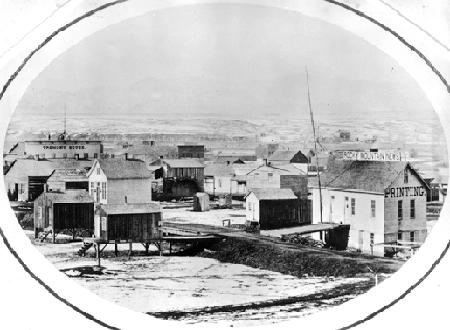
Photo: Denver Public Library, Western History Collection
More About This Topic
Denver began as a supply town for the mining camps in the Rocky Mountains. This photo indicates two of the services the city provided miners and people on their way to the mines. The building on the right is the office of the Rocky Mountain News, Colorado’s first newspaper. The tallest building on the left is the Tremont House hotel.
Their Own Words
"It was an exceedingly primitive town, consisting of numerous tents and numbers of crude and illy constructed cabins, with nearly as many rum shops and low saloons as cabins…. Horses, cows, and hogs roamed at will over the greater part of the village."
Source: Lavina Honeyman Porter (1910), quoted in Lyle Dorsett, The Queen City: A History of Denver (Boulder: Pruett Publishing Co., 1977): 28.
Wagon Train On Market Street- 1868
Wagon trains like the one in this 1868 photo kept Denver supplied with goods from the east. The photo was taken on Market Street.
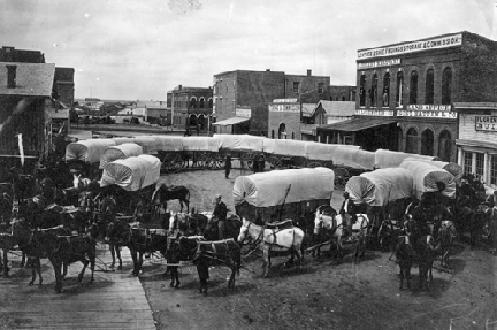
Photo: Denver Public Library, Western History Collection
More About This Topic
Market Street was the center of Denver’s first business district. The signs on the buildings in this photo advertise some of these businesses. They include a land sales office, a leather and shoe store, a saddle and hardware dealer, a storage company, a meat and vegetable market, and a bank.
Their Own Words
"Our city…has in a few months increased to a city of six thousand people; with its fine hotels, stores, manufactories, and all the appliances, comforts and many of the luxuries of civilization…. Great trains of huge prairie freighters arrive and depart almost daily, and more than a thousand emigrant wagons arrive each week."
Source: Rocky Mountain News, June 6, 1860.
Market Street In 1897
This is a photo of Market Street about forty years later. Can you find the electric streetlight in the photo?
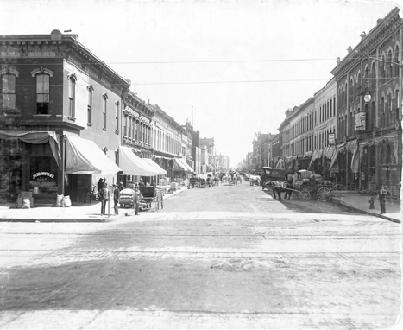
Photo: Denver Public Library, Western History Collection
More About This Topic
By 1900, Market Street had changed. Once a street of retail stores, it had become the center of Denver’s wholesale trade. Farmers sold their vegetables and other produce to the wholesale merchants. They, in turn, sold them to storekeepers and café owners. Denver had electric streets lights by this time. The streetlight bulb can be seen in the upper right part of the photo.
Their Own Words
"The newspapers announced as "approaching the miraculous" the discovery by Thomas A. Edison of the incandescent electric light, so we were prepared for the miracle when April 21, 1883, the just organized Colorado-Edison Electric Light Company placed on display in a vacant store room on Curtis Street a 16-candle power incandescent light, Denver's first. . . . Electricity had come to supplant gas. Soon the residence sections were no longer dark at night. We had lighthouses on the prairies!"
Source: Joseph Emerson Smith, "Personal Recollections of Early Denver," Colorado Magazine, 20 (March 1943): 59.
Larimer Street In The 1880's
This is a photo of busy Larimer Street in the mid-1880s. The vehicles on this busy street include delivery wagons, carriages, and a horse-drawn bus called an omnibus.
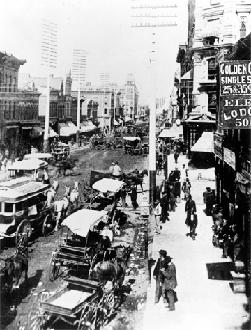
Photo: Denver Public Library, Western History Collection
More About This Topic
Larimer Street was a busy retail district. It had a variety of stores where people came downtown to shop. The streets were crowded with vehicles of all kinds.
Their Own Words
“It had been iterated and reiterated that rain rarely fell in Denver in the summer, yet I recall most definitely that there was a shower or a heavy rain in the city some time every day for nearly three weeks after August sixth. All good Colorado boosters said it was so healthy in the State that no one ever died, they calmly ‘dried up and blowed away.’ So when, as frequently happened, a six-horse-drawn ore wagon was seen stuck hub deep in the mud at the corner of Larimer and Fifteenth Streets I felt sure that there must have been a mixup of ideas over Colorado’s dryness.”
Source: W.H. Bergtold, “Denver Fifty Years Ago,” Colorado Magazine, 8 (March 1931): 67-8.
Seventeenth Street In The 1890's
This is Seventeenth Street in Denver. This photo was taken in the 1890s.
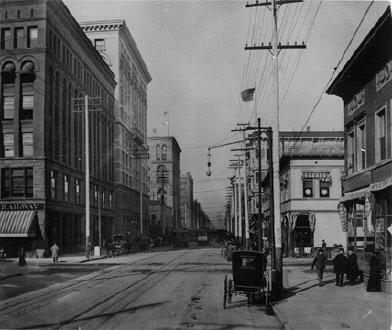
Photo: Denver Public Library, Western History Collection
More About This Topic
Seventeenth Street became the heart of Denver's banking and financial district. The largest banks and investment companies in Colorado were located there.
Their Own Words
“The Depot Loop lines, the Seventeenth Street, the Seventeenth Avenue, and the Colfax Avenue lines are those most used by tourists to reach the various points of interest in Denver. . . . After leaving the Union Depot at the foot of Seventeenth Street, board the Seventeenth Street car, which runs to Broadway, passing the railroad offices and the principal hotels—the Oxford, the Grand Central, the Elk, the Alamo, the Columbia, the Brunswick, the Warren, the Clayton . . . and the Brown Palace (on Broadway). Fare, 5 cents.”
Source: Eugene Parsons, A Guidebook to Colorado (Boston: Little, Brown, 1911): 65, 66.
Inside Colorado State Capitol
This is a photo of the interior of the Colorado State Capitol, which was completed in 1895.
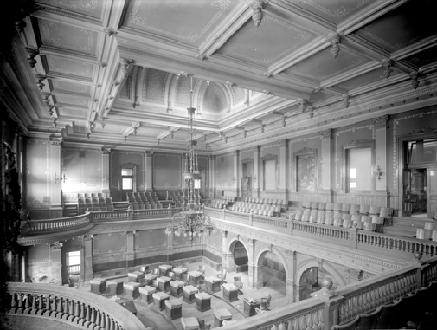
Photo: Denver Public Library, Western History Collection
More About This Topic
Denver also was the state capital. The legislature met for several weeks each year to make laws for the people of Colorado.
Their Own Words
“The Capitol is situated on Capitol Hill, 1 ½ miles from Union Depot. . . . The corner-stone of the Capitol was laid July 4, 1890. . . the building was not completed until 1895. . . . The cost of construction exceeded $2,500,000. . . . The Capitol site includes 10 acres of land [and] the building stands in the center of a beautiful terrace. . . . It was built of native granite, and finished inside with Colorado onyx. The structure is of the Doric order of classic architecture, with Corinthian ornamentations. In its general appearance it is characterized by simplicity and severe grandeur. The interior decorations are tasteful and artistic.”
Source: Eugene Parsons, A Guidebook to Colorado (Boston: Little, Brown, 1911): 75, 77.

